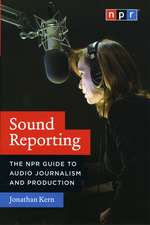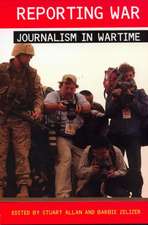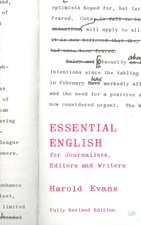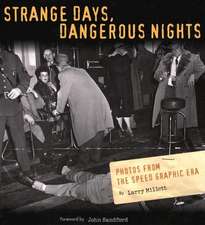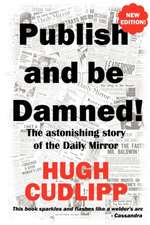The Postwar Decline of American Newspapers, 1945-1965: The History of American Journalism
Autor David R. Daviesen Limba Engleză Hardback – 29 iul 2006 – vârsta până la 17 ani
Preț: 345.90 lei
Preț vechi: 476.40 lei
-27% Nou
Puncte Express: 519
Preț estimativ în valută:
66.20€ • 69.02$ • 55.01£
66.20€ • 69.02$ • 55.01£
Carte tipărită la comandă
Livrare economică 21 martie-04 aprilie
Preluare comenzi: 021 569.72.76
Specificații
ISBN-13: 9780313307010
ISBN-10: 0313307016
Pagini: 200
Dimensiuni: 156 x 235 x 18 mm
Greutate: 0.46 kg
Ediția:New.
Editura: Bloomsbury Publishing
Colecția Praeger
Seria The History of American Journalism
Locul publicării:New York, United States
ISBN-10: 0313307016
Pagini: 200
Dimensiuni: 156 x 235 x 18 mm
Greutate: 0.46 kg
Ediția:New.
Editura: Bloomsbury Publishing
Colecția Praeger
Seria The History of American Journalism
Locul publicării:New York, United States
Notă biografică
David R. Davies is Associate Professor of Journalism and Associate Director at the School of Mass Communication and Journalism at the University of Southern Mississippi. A former reporter for the Arkansas Gazette in Little Rock, he has written extensively about the newspaper industry and its coverage of the civil rights movement.
Cuprins
ForewordTrends in the Postwar Press, 1945-1949Improvement and Criticism, 1945-1949Government, the Cold War, and Newspapers, 1950-`954The Press and Television, 1948-1960Newspapers and the Civil Rights Movement, 1954-1957The Seeds of Long-Term Change, 1950-1963Kennedy and the Press, 1960-1963An Industry in Crisis, 1960-1965960Reflections on the Postwar PressResourcesIndexBibliographic Essay
Recenzii
Davies identifies a steady decline in the US newspaper business during the 20 years following WW II, and he attributes that decline in part to sluggish business practices, including the country's lethargic conversion to new printing technologies. He notes that newspapers during this period were passive about covering the Civil Rights Movement and failed to introduce journalistic innovations to compete with the growing audience for television news. Davies explains how sociological, legal, political, and cultural changes, as well as differences within the journalism community, influenced the newspaper industry's decline. He provides excellent detail about the early history of US television news. Joining a series intent on revitalizing scholarship on the history of American journalism, this book is easy to read and carefully annotated. A thematic bibliographic essay highlights other readings. Highly recommended. All readers; all levels.
The Postwar Decline of American Newspapers, 1945-1965 is a long-overdue study of a neglected time in journalism history..The volume demonstrates that Davies has a broad grasp of postwar journalism history generally, and it is especially useful in that it goes beyond the standard recital of famous personalities and events to offer some meaningful analysis of the technological changes, shifting attitudes about press/government relations, internal debates about professional standards, and competition from other media that threatened the industry.
It is my dream that Davies' book will be read and talked about by journalism historians and students. It is equally essential that it be pondered by professional journalists, editors, and publishers, who cumulatively have contributed to the lemming-like leadership of an industry in decline in the post World War II period until 1965. Davies' book may be just a tiny step to help stomp upon the lemmings who continue to lead the newspaper business over the cliff in the twenty-first century. But at least his book looks like a stomp in the right direction.
Davies seeks to explain the slow and steady decline of American newspapers in the two decades following World War II. He argues that the country's publishers and editors failed to respond to the need for more long-term analysis in their reporting of such broad societal changes as the Civil Rights movement and failed to recognize the challenge posed by television. He also looks at the impact of rising costs, demographic change such as suburban migration, and changing government-press relations.
This book includes a bibliographic essay, extensive footnotes, and an outstanding bibliography. It should be a handy reference for anyone with a professional interest in media. It is both scholarly and accessible and should provoke thought among media professionals about how to respond to the challenges of convergence..Every newspaper publisher in the U.S. should read this book for guidance in how to respond to today's news changes.
The Postwar Decline of American Newspapers, 1945-1965 provides a thoughtful overview of significant trends affecting newspapers during the post-war era..[m]akes a valuable contribution to the field of journalism history.
The Postwar Decline of American Newspapers, 1945-1965 is a long-overdue study of a neglected time in journalism history..The volume demonstrates that Davies has a broad grasp of postwar journalism history generally, and it is especially useful in that it goes beyond the standard recital of famous personalities and events to offer some meaningful analysis of the technological changes, shifting attitudes about press/government relations, internal debates about professional standards, and competition from other media that threatened the industry.
It is my dream that Davies' book will be read and talked about by journalism historians and students. It is equally essential that it be pondered by professional journalists, editors, and publishers, who cumulatively have contributed to the lemming-like leadership of an industry in decline in the post World War II period until 1965. Davies' book may be just a tiny step to help stomp upon the lemmings who continue to lead the newspaper business over the cliff in the twenty-first century. But at least his book looks like a stomp in the right direction.
Davies seeks to explain the slow and steady decline of American newspapers in the two decades following World War II. He argues that the country's publishers and editors failed to respond to the need for more long-term analysis in their reporting of such broad societal changes as the Civil Rights movement and failed to recognize the challenge posed by television. He also looks at the impact of rising costs, demographic change such as suburban migration, and changing government-press relations.
This book includes a bibliographic essay, extensive footnotes, and an outstanding bibliography. It should be a handy reference for anyone with a professional interest in media. It is both scholarly and accessible and should provoke thought among media professionals about how to respond to the challenges of convergence..Every newspaper publisher in the U.S. should read this book for guidance in how to respond to today's news changes.
The Postwar Decline of American Newspapers, 1945-1965 provides a thoughtful overview of significant trends affecting newspapers during the post-war era..[m]akes a valuable contribution to the field of journalism history.








